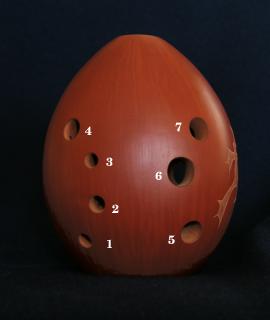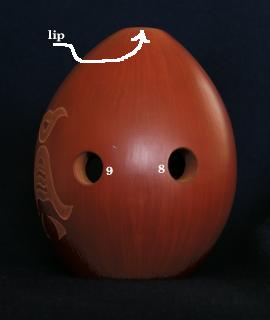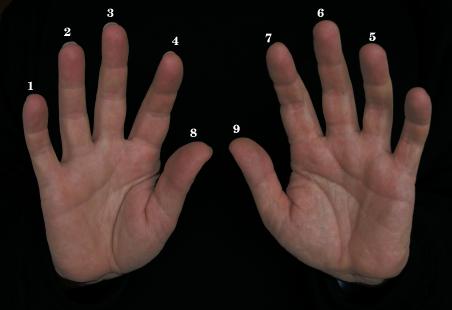|
||
|
With all finger holes covered, blow gently straight across the blow hole. This should produce the "base" tone of the xun. Check the pitch against a piano or electronic tuner. My best xun (the one pictured) is conveniently marked with the name of its base tone "E" on its flat bottom, so I know what pitch I'm shooting for.
Pitches lower than the base tone are produced by blowing down into the xun and partially covering the blow hole with the lower lip. You will want to be able to control pitches down to an octave below the base tone. This may be difficult at first, as the lowest pitches will sound only faintly and will be hard to control. It's well worth the effort and practice, however, since as noted above the range of the xun will not extend upward by overblowing harmonics.
The position or placement of holes on a xun doesn't influence the pitch, as it does for flutes. If we ignore the angle of the windstream, the pitch is determined by the total area of open holes. This means that opening any one of the finger holes while playing the base tone raises the pitch, by a half or whole step depending on the size of the hole opened. Try it! Opening a second hole should raise the pitch again. Clearly, there will be many ways to "finger" each note, instead of just one fingering per pitch as we find on a flute. But to use the instrument musically, we should settle on a system of fingerings and use it consistently. The table below shows the fingerings I use on my E xun. For convenience, the pitches are named with their solfege (or jian pu) pitch numbers, rather than western note names. So my E is 1 (do), F sharp is 2 (re), and so on.
| Pitch | Fingering |
| 1 | All holes closed |
| 2 | Open hole 1 |
| 3 | Open holes 1, 3 |
| 4 | Open holes 1, 2, 3 |
| 5 | Open holes 1, 2, 3, 5 |
| 6 | Open holes 1, 2, 3, 5, 7 |
| 7 | Open holes 1, 2, 3, 5, 6, 7 |
| . 1 | Open holes 1, 2, 3, 4, 5, 6, 7 |
| . 2 | Open holes 1, 2, 3, 4, 5, 6, 7, 9 |
| . #2 | Open holes 1, 2, 3, 4, 5, 6, 7, 8, 9 |
You might notice that pitches above 7 require you to lift all fingers. Don't drop the xun! You must shift your hand around so the instrument is still supported, without covering the finger holes.
Click here for a rendition of an ancient Chinese melody, Phoenix-Shaped Hairpin, played on the xun in E.


